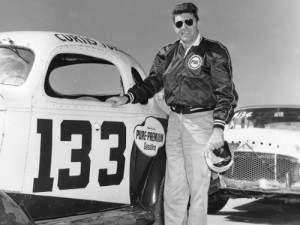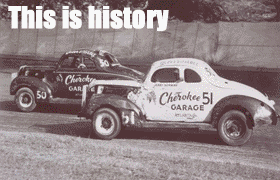
Curtis Turner poses with the car he drove to a second-place finish in the NASCAR Modified-Sportsman race on the Daytona Beach-Road Course On Friday, he will be inducted into the NASCAR Hall of Fame. Photo: ISC Archives via Getty Images
Curtis Turner lived life and stock car racing in the same manner – at full throttle.
A bootlegger at age nine, the Virginia native was a self-proclaimed millionaire at 20 and made and lost several fortunes while becoming one of the greatest drivers – and most colorful characters – of NASCAR’s pioneer era.
He won a lot but also wrecked just as often. His parties were legendary and lengthy, as were Turner’s on and off-track antics in rental cars and airplanes – which frequently involved his friend and NASCAR Hall of Famer Joe Weatherly.
Called NASCAR’s first bad boy in the same-titled biography authored by Alan Hill and Dennis Treece, Turner was described as partier, playboy, innovator and entrepreneur with an edgy spirit that “drove him through one of the most cantankerous lives ever lived.”
Sports Illustrated, pointing to his 350 career victories – 17 in NASCAR’s premier division – anointed Turner the Babe Ruth of Stock Car Racing.
NASCAR Founder William H.G. “Big Bill” France, who banned Turner for attempting to unionize drivers and later reinstated him, said in 1972, “Curtis Turner was the greatest race car driver I have ever seen.”
NASCAR Hall of Famer Glen Wood, in whose Ford Turner won his final premier series race at North Carolina Motor Speedway in 1965, said Turner “was the best at controlling a car and putting it where he wanted it (as) anybody I’ve ever seen.” Recalling the days in which the two battled on dirt tracks, Wood added, “If he got a fender inside of you, you were passed.”
Turner, killed at age 46 when the airplane he was piloting crashed in Pennsylvania in 1970, will be inducted into the NASCAR Hall of Fame on Friday in Charlotte, North Carolina, along with Jerry Cook, Bobby Isaac, Terry Labonte and O. Bruton Smith.
Turner was born in the Virginia mountain community of Floyd in 1924. The Great Depression soon followed and it was no surprise he had to grow up quickly.
“Those were hard times back in the hills and you did things you shouldn’t to get by,” Turner said of his brief liquor-running days. “I’m not proud of my past, but I’m proud of the future I made for myself.”
By the time he was 14, Turner was cutting timber for 15 cents an hour and at age 20 owned three sawmills and related equipment. He competed in his first stock car race at Mt. Airy, North Carolina in 1946. Turner finished 18th in a field of 18 but won his next start.
He was known as the “Blond Blizzard of Virginia” early in his career, a nickname that was soon shed in favor of “Pops,” a name he often used to refer to others.
Turner was in the field for NASCAR’s first race at North Carolina’s Charlotte Speedway on June 19, 1949. He finished ninth in his own 1946 Buick on the .750-mile dirt track. Switching to a 1949 Oldsmobile fielded by Hubert Westmoreland, Turner captured his first victory in the season’s fourth race at the legendary one-mile Langhorne Speedway in Pennsylvania. He would defend the win on the dirt oval in 1950.
The 1949-50 seasons were the only ones in which Turner ran anything resembling a full schedule in NASCAR’s premier series, finishing sixth and fifth in the points standings. His four wins in 1950 – at Langhorne, Rochester, NY, Martinsville Speedway in Virginia and Charlotte Speedway – were a season high. Turner led every lap from the pole in consecutive starts at Rochester and Charlotte, the first and only driver to accomplish the feat in the premier series.
“If you feel like you’re in control (of your car), you ain’t going fast enough,” said Turner, partially explaining his hit and miss results on the dirt-surfaced tracks of NASCAR’s early years.
Turner won twice on paved superspeedways – at Rockingham and Darlington Raceway where he captured the 1956 Southern 500.
It’s fair to say Turner was at his best in NASCAR’s convertible division driving factory-backed Fords and winning 38 times. Twenty-two of those victories came in 1956 when he finished third in points. Turner’s 23 poles also marked a record for the short-lived division.
Turner’s strangest victory may have come Sept. 30, 1956 at Asheville-Weaverville Speedway in North Carolina, where a 14-car pileup on a dust-shrouded track resulted in the race being declared complete. Turner’s Ford was the only car still running at the red flag – a first and last in a major NASCAR event.
A member of the Motorsports Hall of Fame of America and International Motorsports Hall of Fame, Turner was selected as one of NASCAR’s 50 Greatest Drivers in 1998.





















Leave a Reply
You must be logged in to post a comment.